Dashboard creation shouldn’t crash during your most important presentation. Your reports shouldn’t take forever to load. And you definitely shouldn’t lose data when two people edit the same report.
Yet these frustrations plague Looker Studio users daily.
While Google’s free business intelligence tool democratized data visualization, its limitations become painfully obvious when your data grows or your needs evolve. Performance bottlenecks, strict data limits, and collaboration nightmares drive teams to explore alternatives.
In this guide, you’ll discover 10 powerful alternatives ranging from enterprise-grade platforms to user-friendly tools that might serve your team better than Looker Studio.
What is Looker Studio?
Looker Studio transforms raw data into interactive dashboards and reports. Google’s free business intelligence tool connects to various data sources, with particularly strong integration across the Google ecosystem.
Core features include:
Dashboard creation:
- Drag-and-drop interface with customizable charts, tables, and visualizations
- Responsive design adapting dashboards for mobile and desktop viewing
- Visual report builder for non-technical users
Data connectivity:
- Native Google integration seamlessly connecting Analytics, Ads, Sheets, and BigQuery
- Data blending capabilities combining up to 5 sources per report
- Third-party connector ecosystem
Collaboration features:
- Real-time collaboration with multi-user editing and sharing
- Team workspace organization
- Report sharing and embedding options
Accessibility:
- Free tier access making data visualization accessible to small teams
- No upfront costs for basic functionality
Target audience and pricing
The platform targets three main groups:
- Marketers needing campaign performance dashboards
- Small businesses requiring affordable BI capabilities
- Teams heavily invested in Google’s ecosystem
Pricing starts free with paid Pro features adding higher API limits and faster refresh rates for approximately $400 per user annually.
Why look for Looker Studio alternatives?
Several critical limitations drive teams toward other solutions, creating genuine business problems that impact productivity and decision-making.
Performance problems plague complex reports
System reliability issues:
- Slow loading times with large datasets
- Frequent crashes during important presentations
- System freezes when blending multiple sources
- These issues are architectural, not network-related
Impact on business operations:
- Unreliable performance during critical meetings
- Lost productivity due to system downtime
- Inability to trust the platform for important decisions
Strict data limitations constrain growth
Row and file restrictions:
- Most datasets capped at 1 million rows
- Some connectors limit this to just 150,000 rows
- File uploads max out at 100MB per dataset
- 2GB total storage per user – insufficient for agencies
Business growth constraints:
- Cannot scale with increasing data volumes
- Forces workarounds that add complexity
- Limits analytical depth and historical analysis
Data blending restrictions force workarounds
Technical limitations:
- 5-source limit per blended dataset proves inadequate
- Complex multi-channel reporting becomes impossible
- Teams resort to using Google Sheets as intermediary
- Adds maintenance overhead and potential failure points
Business impact:
- Incomplete view of cross-channel performance
- Manual processes that should be automated
- Increased risk of errors in critical reports
Collaboration features remain unreliable
Multi-user editing problems:
- Generates glitches and system errors
- Occasional data loss during collaborative editing
- Version conflicts and overwrites
Workaround solutions:
- Manual check-out systems to avoid conflicts
- Scheduled editing windows between team members
- Defeats the purpose of real-time collaboration
Limited customization hampers professional presentation
Branding and design restrictions:
- Branding options remain restricted
- Mobile experiences lag behind competitors
- Advanced formatting capabilities fall short
Client presentation challenges:
- Reports don’t meet professional presentation standards
- Limited white-labeling options for agencies
- Difficulty creating client-ready deliverables
Support gaps frustrate users
Limited assistance:
- Free tier users receive minimal customer support
- Slow response times for issue resolution
- Limited learning resources make troubleshooting difficult
Top 10 Looker Studio alternatives
1. Power BI
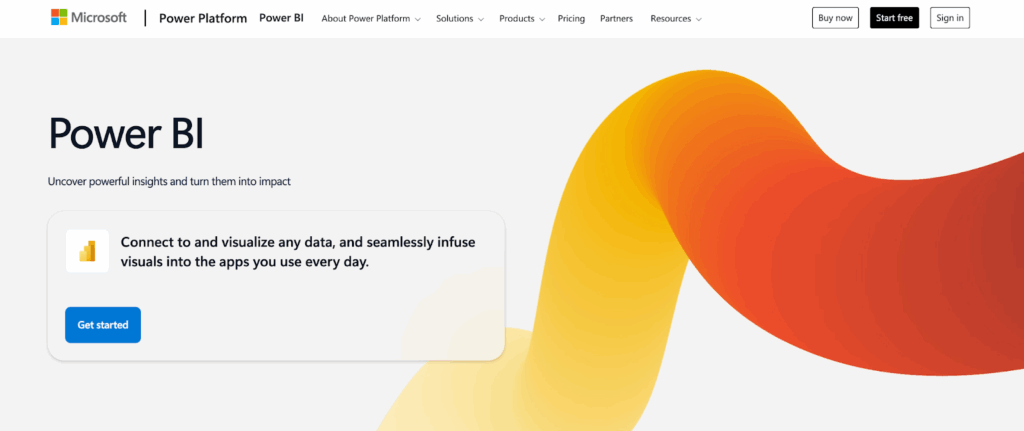
Power BI delivers Microsoft’s enterprise business intelligence platform with advanced analytics and deep Office 365 integration.
Key strengths:
Data connectivity and performance:
- Extensive data connectivity supporting wide variety of sources
- Optimal performance with Microsoft stack
- Better performance handling large datasets without crashes
Advanced capabilities:
- AI-powered insights including predictive modeling
- Custom DAX calculations for complex analysis
- Enterprise-grade security with role-based access
- Compliance certifications and governance controls
Integration advantages:
- Seamless Microsoft integration with Azure, Office 365, SQL Server
- Natural workflow with Teams and other Microsoft tools
- Familiar interface for Microsoft-centric organizations
Best for: Microsoft-centric organizations, enterprise analytics teams, and businesses requiring advanced BI capabilities.
Pricing: Starts around $10 per user monthly for Power BI Pro with Premium tiers scaling based on capacity needs.
How it compares to Looker Studio: More powerful and reliable but higher cost and complexity. Ideal for organizations already invested in Microsoft ecosystem wanting enterprise-grade business intelligence.
2. Tableau

Tableau sets the industry standard for data visualization with sophisticated analytics and unlimited customization options.
Key strengths:
Visualization excellence:
- Advanced visualization capabilities with extensive customization
- Interactive storytelling features
- Industry-leading chart types and design options
Performance and reliability:
- Superior performance optimized for large, complex datasets
- No crashes or performance issues that plague Looker Studio
- Handles enterprise-scale data volumes
Deployment flexibility:
- Flexible deployment options supporting cloud, on-premises, hybrid
- Extensive connector ecosystem for multi-cloud environments
- Professional analytics with statistical functions
Advanced features:
- Forecasting and predictive analytics
- Advanced data exploration capabilities
- Custom calculations and complex analysis
Best for: Data analysts, enterprises requiring sophisticated visualizations, and technical teams comfortable with learning curves.
Pricing: Ranges from $15-70 per user monthly depending on role requirements, with Creator licenses needed for content authoring.
How it compares to Looker Studio: Significantly more capable but expensive. Perfect for organizations prioritizing visualization power over cost savings and willing to invest in user training.
3. Coefficient

Coefficient transforms ordinary spreadsheets into powerful business intelligence platforms by connecting Google Sheets and Excel directly to live business data.
Key strengths:
Spreadsheet-native approach:
- Eliminates learning curves by working within familiar interfaces
- Google Sheets and Excel integration
- Teams continue using tools they already know
Comprehensive data connectivity:
- Live data connections to 70+ business systems
- Salesforce, HubSpot, SQL databases, analytics platforms
- No data limitations avoiding file size and row restrictions
- Two-way data sync enabling source editing from spreadsheets
AI-powered capabilities:
- AI Sheets assistant automatically builds dashboards
- Writes SQL queries using business context
- Analyzes data patterns and suggests insights
- Creates charts, pivot tables, conditional formatting
Collaboration advantages:
- Superior collaboration leveraging proven spreadsheet sharing
- No multi-user editing problems like Looker Studio
- Familiar permission and sharing models
Best for: Marketing, sales, and operations teams wanting powerful BI capabilities without abandoning familiar spreadsheet workflows.
Unique value proposition: Coefficient eliminates the choice between familiar tools and powerful data capabilities. Teams get enterprise-grade live data integration while working in spreadsheets they already know and love.
How it compares to Looker Studio: More reliable performance with no data restrictions, familiar interface requiring zero training, and superior collaboration capabilities. Perfect for teams frustrated with Looker Studio’s limitations but unwilling to learn complex new platforms.
4. Qlik Sense
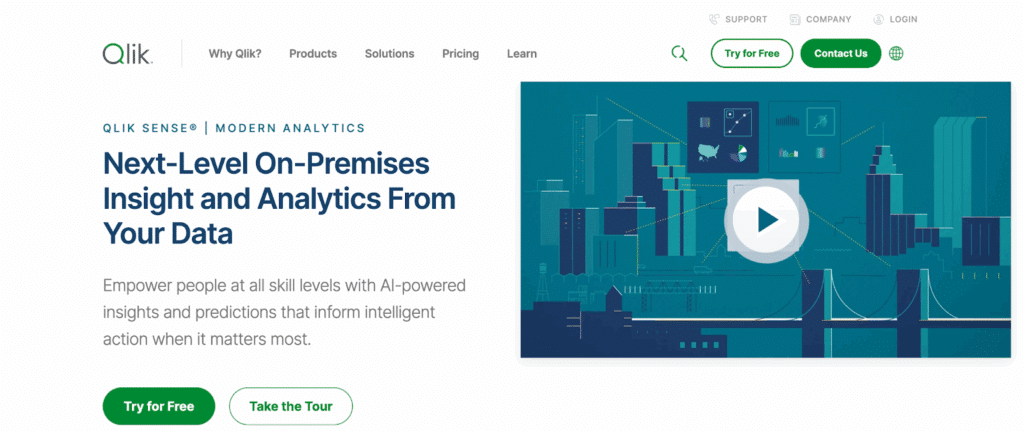
Qlik Sense provides commercial business intelligence with advanced analytics, AI-powered insights, and self-service dashboard creation.
Key strengths:
Advanced analytics engine:
- Associative analytics enabling exploration of data relationships
- Hidden pattern discovery and data connections
- Advanced exploration capabilities
AI and automation:
- AI-driven insights with automated pattern detection
- Anomaly identification and predictive modeling
- Self-service capabilities for business users
Enterprise features:
- Hybrid cloud flexibility supporting various deployment models
- Enterprise security with comprehensive governance
- Access controls and audit capabilities
Best for: Enterprises needing deep analytics, predictive modeling, and dedicated professional support.
Pricing: Custom enterprise pricing typically higher than Looker Studio but includes comprehensive support and advanced features.
How it compares to Looker Studio: More sophisticated analytics capabilities with better enterprise support, but higher cost and complexity. Suitable for organizations outgrowing Looker Studio’s analytical limitations.
5. Metabase

Metabase offers open-source business intelligence focused on user-friendly data exploration for non-technical teams.
Key strengths:
User-friendly design:
- Intuitive interface designed for business users
- No coding requirements for basic functionality
- Visual SQL builder for complex queries
- Quick setup and deployment process
Open-source advantages:
- Open-source foundation with community support
- Vendor independence and transparency
- Cost-effective options with free community version
- Affordable managed hosting available
Accessibility:
- Faster deployment than traditional BI platforms
- Lower technical barriers for business teams
- Simple data exploration capabilities
Best for: Business teams seeking simple BI capabilities without technical complexity or high costs.
Pricing: Includes free open-source version with paid cloud hosting and enterprise features available.
How it compares to Looker Studio: Similar ease of use but with open-source flexibility and potentially lower costs. Good option for teams wanting simplicity without Google ecosystem lock-in.
6. Grafana
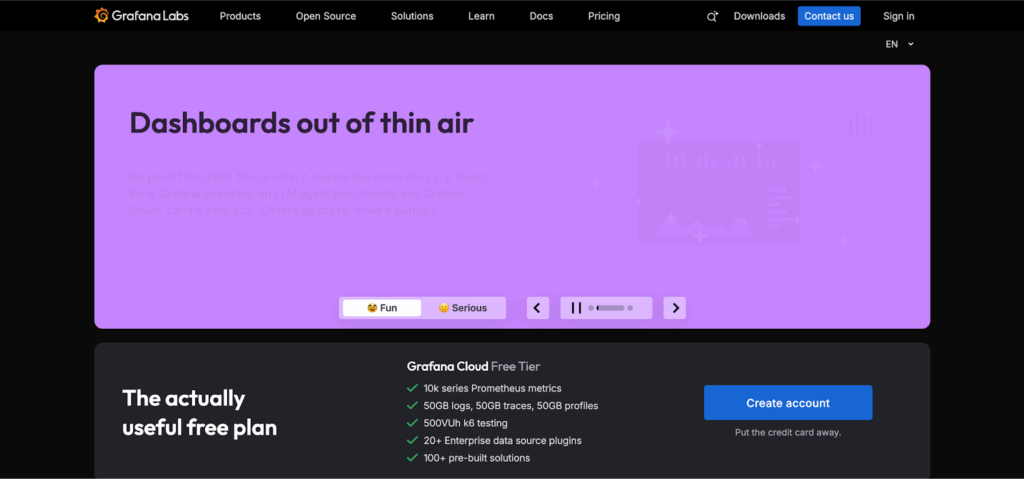
Grafana specializes in real-time monitoring and time-series data visualization, particularly valuable for technical and operational use cases.
Key strengths:
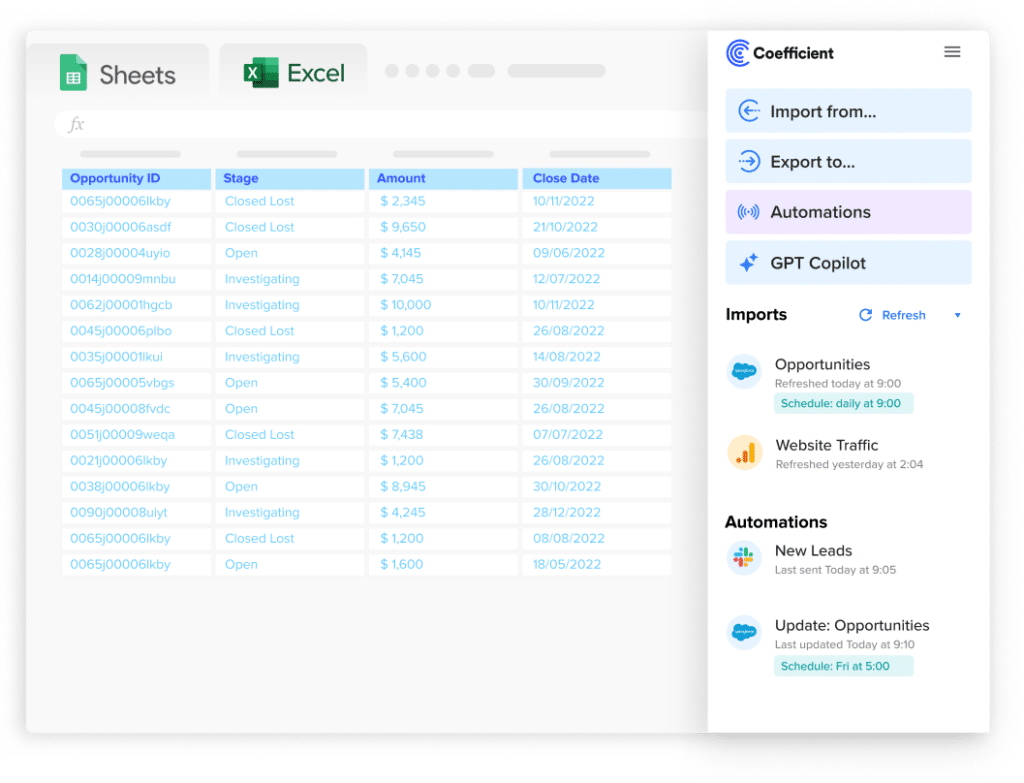
Stop exporting data manually. Sync data from your business systems into Google Sheets or Excel with Coefficient and set it on a refresh schedule.
Get Started
Real-time monitoring excellence:
- Live data streaming with immediate updates
- Time-series optimization for metrics and performance data
- System monitoring and operational intelligence
Customization and flexibility:
- Extensive customization with flexible dashboard creation
- Plugin ecosystem for extended functionality
- Multi-data source support for monitoring platforms
Technical capabilities:
- Alerting capabilities with proactive notifications
- Automated response systems
- DevOps and technical monitoring focus
Best for: IT teams, DevOps professionals, and technical users requiring system monitoring and real-time data analysis.
Pricing: Free open-source version available with Grafana Cloud offering managed services and enterprise features.
How it compares to Looker Studio: Superior for technical monitoring and real-time use cases, but less suitable for general business analytics. Ideal for teams prioritizing operational intelligence over marketing dashboards.
7. Klipfolio
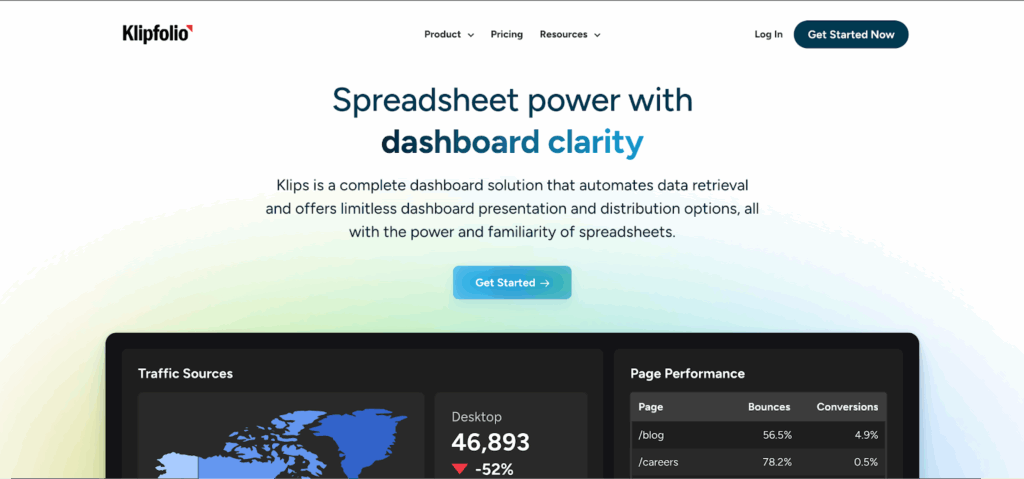
Klipfolio focuses on business performance monitoring and KPI tracking with flexible data integration options.
Key strengths:
KPI-focused design:
- Specifically created for business performance monitoring
- Executive dashboard capabilities
- Performance indicator specialization
Data connectivity:
- 300+ data connectors supporting various business applications
- API integration capabilities for custom connections
- Automation and scheduling features
Business accessibility:
- Affordable pricing model for small to medium businesses
- Flexible visualization options with customizable charts
- Performance-focused dashboard creation
Best for: Small to medium businesses with technical resources needing performance-focused dashboards.
Pricing: Tiered pricing based on dashboards and users generally more affordable than enterprise alternatives.
How it compares to Looker Studio: More focused on KPIs and business metrics with better data refresh capabilities, but requires more technical setup than Looker Studio’s plug-and-play approach.
8. ChartIO (Discontinued)
Service status: ChartIO was acquired by Atlassian and discontinued in March 2022.
Historical context: Previously offered user-friendly data visualization for startups and small businesses with simple dashboard creation capabilities.
Migration recommendations for former ChartIO users:
- Metabase for open-source alternatives
- Grafana for technical monitoring needs
- Coefficient for spreadsheet-native business intelligence
9. Sisense
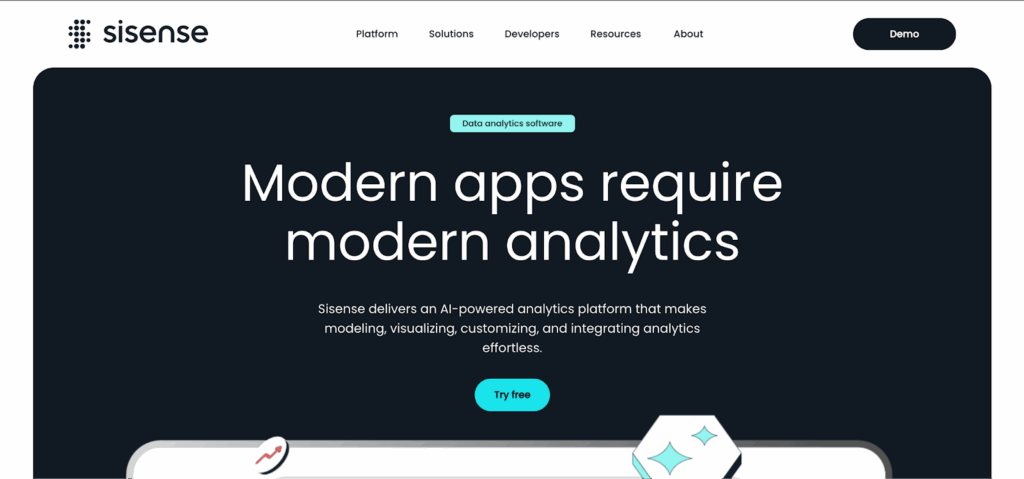
Sisense provides enterprise business intelligence with embedded analytics capabilities and sophisticated data modeling features.
Key strengths:
Embedded analytics capabilities:
- BI integration directly into applications and customer portals
- White-label options with custom branding
- Customer-facing analytics solutions
Advanced data modeling:
- Complex transformations and custom business logic
- AI-powered insights with automated analysis
- Pattern recognition capabilities
Enterprise architecture:
- Scalable architecture for enterprise deployments
- High-volume usage optimization
- Advanced data processing capabilities
Best for: Mid-market and enterprise customers needing embedded analytics or sophisticated data modeling.
Pricing: Custom annual subscription pricing not publicly available, typically targeting larger organizations.
How it compares to Looker Studio: More sophisticated modeling and embedding capabilities but significantly higher cost and complexity. Suitable for organizations needing advanced analytics integrated into their products.
10. Domo
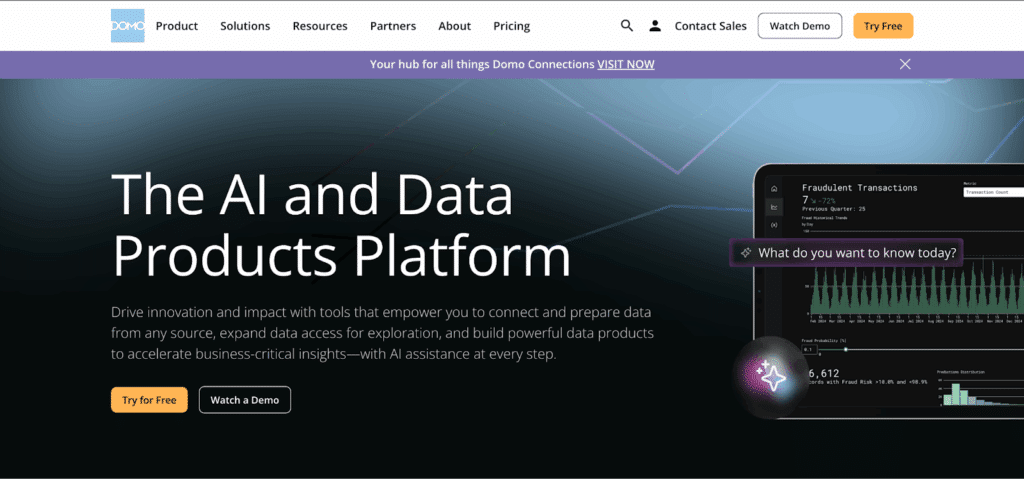
Domo delivers comprehensive enterprise business intelligence with extensive integrations, advanced collaboration, and mobile-first design.
Key strengths:
Massive integration ecosystem:
- 1,000+ data source connectors far beyond Google’s offerings
- Comprehensive business system coverage
- Multi-cloud and hybrid environment support
Mobile and collaboration excellence:
- Superior mobile experience with native iOS/Android apps
- Built-in collaboration tools including communication features
- Workflow management and team coordination
Advanced capabilities:
- AI and machine learning for predictive analytics
- Automated insights and pattern recognition
- Enterprise security with end-to-end encryption
- Governance controls and compliance certifications
Best for: Large enterprises with complex BI requirements and substantial technology budgets.
Pricing: Custom enterprise pricing known to be expensive and targeted specifically at large organizations.
How it compares to Looker Studio: Far more capable but dramatically more expensive. Ideal for enterprises that have outgrown Looker Studio’s capabilities and need comprehensive business intelligence platforms.
How to choose the right alternative
The right choice depends on your team’s specific needs, constraints, and goals.
Key evaluation criteria
Performance requirements should guide initial filtering:
- If Looker Studio crashes and slow loading frustrate your team
- Prioritize alternatives known for reliability like Power BI, Tableau, or Coefficient
- Consider data volume and complexity requirements
Technical expertise determines feasibility:
- Coefficient works in familiar spreadsheets requiring zero training
- Tableau demands analytical skills and technical comfort
- Grafana needs technical knowledge for setup and maintenance
- Match platform complexity with your team’s capabilities
Budget constraints eliminate many options quickly:
- Looker Studio’s free tier appeals to cost-conscious teams
- Metabase offers open-source freedom with optional paid hosting
- Power BI provides enterprise features at reasonable costs
- Consider total cost of ownership including training
Integration needs affect long-term success:
- Teams heavily invested in Google ecosystem might prefer staying despite limitations
- Microsoft shops benefit from Power BI’s native integration
- Coefficient specializes in business system connections
Data volume expectations eliminate unsuitable options:
- Large dataset requirements rule out tools with strict limits
- Growing data needs favor scalable platforms over simple solutions
- Consider future growth and analytical complexity
Key evaluation questions
Before making a decision, answer these critical questions:
- What data volumes do we typically analyze?
- How important is real-time collaboration?
- Do we need advanced analytics or simple dashboards?
- What’s our tolerance for learning new interfaces?
- How much are we willing to invest in training and setup?
- Do we need mobile access and responsive design?
- What’s our budget for BI tools annually?
Make the smart choice
The right business intelligence platform transforms how your team understands and acts on data. Whether you need Tableau’s visualization power, Power BI’s enterprise integration, or Coefficient’s spreadsheet familiarity, better tools accelerate insights and improve decision-making.
Don’t let Looker Studio’s limitations hold back your team’s potential. Performance problems, data restrictions, and collaboration issues waste time that could be spent generating insights and driving results.
The best alternative isn’t always the most feature-rich—it’s the one your team will use effectively without fighting the platform every day.
Ready to upgrade your business intelligence? Get started with Coefficient and experience powerful BI capabilities in the spreadsheets your team already masters.

